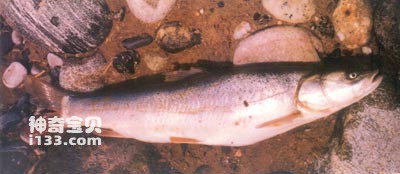Aspiorhynchus laticeps belongs to the order Cypriniformes, family Cyprinidae, subfamily Schizothorax, and genus Aspiorhynchus laticeps. Commonly known as: bull fish, tiger fish. English name: Big head schizothracin.
Endangerment level: Endangered. China's national first-level protected wild animals.
The body is slender and flat on the sides, with a raised back and a round abdomen. big head. The kiss is wide and flat. The mouth is wide and cleft obliquely. The front end of the lower jaw is thicker and slightly longer than the upper jaw. Its edge is horny. There must be 1 pair, located at the corner of the mouth. Small eyes. The gill openings are large and the gill isthmus is narrow. There are 105-115 lateral line scales. The chest is exposed, the abdominal scales are buried under the skin, the anal fin is well developed, the dorsal fin has strong spines, the trailing edge is serrated, and the starting points of the dorsal and pelvic fins are opposite. The dorsal side of the body is blue-gray, the abdomen is silver-white, the chest, abdomen and anal fins are light orange-red, and the tail fin is light red.

A large bottom-dwelling fish that lives in lakes and rivers. Its habitat can be either still water or slow flow. It is a ferocious carnivorous fish that feeds on fish and aquatic insects. At the end of April and early May, they go upstream to lay eggs. The individual is larger, with the maximum length reaching 2 meters.
The flatnose is a fish endemic to the Tarim Basin in Xinjiang. It is only distributed in the Tarim River system at an altitude of 800-1,200 meters.
The flatnose fish was originally one of the fishing targets in the production area, and there is a certain amount. Since the 1970s, the number has dropped sharply. Today, very few survive and it has become an endangered species. The reasons for the endangered species are largely restricted by its biological characteristics, such as its old age at maturity, low fecundity, inability to move quickly and predatory, and its high requirements for living and spawning environments, resulting in a small population of this species. Narrow distribution. Water conservancy construction in recent years has isolated the spawning and migration channels of this species, affecting the population replenishment. In addition, due to inadequate protection, overfishing, the introduction of alien species, and agricultural water use to lower water levels and reduce water volume, etc., directly destroy the replenishment of resources.
animal tags:
We created this article in conjunction with AI technology, then made sure it was fact-checked and edited by a Animals Top editor.